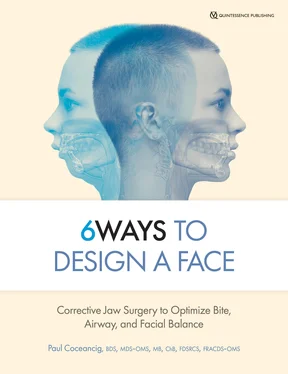1 ...7 8 9 11 12 13 ...16 All illustrations have a full complement of 32 teeth—in various patterns of eruption or crowding or alignment or development or impaction. In each series of this set of four, part a shows a normal mandible, with or without a chin button. Parts b to f show AMHypo with and without agenia, respectively. In b to f , the small mandible proportions are exactly the same between each illustration, and only the pattern of dental crowding is different. All have impacted third molar development as well.
Parts c to f show AMHypo as well as relative smallness of the maxilla, known as maxillary hypoplasia , which is always associated with additional nasal airway issues further complicated by the small mandible.
Which profile the patient displays, and which treatment philosophy you choose, will define everything that will follow. The only fundamental differences are whether there is agenia or not, AMHypo or not, and maxillary hypoplasia or not. The decision to treat the malocclusion class is not based on numbers contrived through lateral cephalometry. It is based on rationalizing that 32 teeth are normal and that we must volumetrically assess the ideal positioning of these 32 teeth, a normally spaced airway, and a normally proportioned profile, all within patient-specific facial volumetric needs to accommodate all internal anatomy.
The questions then become: How do I fit everything in? How do I keep everything? What do I need to make bigger? What steps do I need to take to move from small to normal? How do I make this specific individual with all her myriad issues “normal”? And how do I reclassify everything to see the pattern of it all and at once?
A NEW ORTHOGNATHIC CLASSIFICATION
In order to merge all the different themes of treatment, I propose that there is a need for a different way to orthognathically classify the average profile of a face. By average , I mean 98% of us, excluding the 2% that fall into a battle of an infinite variety of subtle or imagined abnormality. This classification therefore is of facially normal variance based on the almost absolute commonality of AMHypo. Ours is not a discussion on the pathologic variances of a thousand other vague and rare conditions. Of course not every single person in every single instance will fall easily into this subclass of this or that, but the overwhelming majority will.
In my assessment, the current means of orthodontic malocclusion classification ignores everything outside of the bite anyway, including the “why” of how a particular and common malocclusion occurs. And if we don’t know the common “why,” then we will never know how to fix almost everything.
AMHypo is so ubiquitous, and so common, that we see it as normal; and because it is normal, we don’t see it at all.
In my classification ( Figs 1-13to 1-16), I still use the principles of Class I, II (including divisions 1 and 2), and III malocclusions that Angle first defined, but I also give an added viewpoint of how anterior open bite develops. In my mind, these abnormal states of facial profile and bad bite fall on a spectrum ( b through f ), but they all have exactly the same small mandible. The base condition is always AMHypo. In my mind, AMHypo is so ubiquitous, and so common, that we see it as normal; and because it is normal, we don’t see it at all.
But to say AMHypo is abnormal, my first classification type is to describe the ideal. Thus I define the first state—Class I normal occlusion with 32 uncrowded teeth in a normal adult face. This is the anatomical and treatment ideal toward which we convert the AMHypo state, and from it relieve the patterns of airway, facial, and dental issues AMHypo causes. To accept this state is to believe that all of us should functionally develop 32 teeth—our teeth—as a normality of being our individual versions of human.
If you cannot accept this premise of my view of the ideal universal Class I occlusion founded on 32 teeth, then the rest of this book will be nonsense to you.
Pretreatment profile classification
My baseline dental assumption is that if there is nondevelopment of individual permanent teeth, it is because the teeth did not bud and therefore develop crowding or impaction. In my view, the lack of an individual random tooth is due to lack of local volume and not the result of specific genetic predetermination. A normal human complement of teeth is 32.
CLASS A
Class A describes a normal complement of 32 teeth without crowding in Class I orthodontic occlusion, with or without a chin button. There is no AMHypo. This may be called “Class I occlusion with no dental crowding and full dentition.” This state is the gold-standard ideal outcome for all treatments that we apply to a face, jaws, and occlusion. There is no glossoptosis.
CLASS B
Class B describes the presence of AMHypo, with or without a chin button, with normal development of 32 teeth but with at least the mandibular third molars impacted. There is little remaining dental crowding, and the prominent anterior teeth are in an Angle Class II, division 1 pattern. There is normal maxillary development, though it is usually narrow posteriorly. This may be called “Class II malocclusion with prominent anterior teeth” or “Class II, division 1 malocclusion.” There is inherent glossoptosis.
CLASS C
Class C also describes the presence of AMHypo, with or without a chin button, with normal development of 32 teeth but with all third molars impacted. There is significant dental crowding in the maxilla, such that the anterior teeth lean inward, reducing the natural dental overjet. The maxilla is not typically narrow, but it may be slightly shorter anteroposteriorly. There is relatively little mandibular dental crowding. This may be called “Class II malocclusion with collapsed maxillary anterior teeth” or “Class II, division 2 malocclusion.” There is glossoptosis.
CLASS D
Class D describes the presence of AMHypo, with or without a chin button, with normal development of 32 teeth. There is severe dental and incisor crowding in both jaws, but a Class I molar relationship is preserved. This may be called “Class I malocclusion with dental crowding.” The third molars are usually all impacted. The maxilla is developmentally small, and there is glossoptosis.
CLASS E
Class E describes the presence of AMHypo with normal development of 32 teeth but with almost universal impaction of the third molars, particularly in the maxilla. The teeth are severely crowded, and the very small relative size of the maxilla brings the incisor relationship into a reverse overjet (the maxillary anterior teeth lie behind the mandibular anterior teeth). The overwhelming etiologic cause is the primary AMHypo, leading to chronic open mouth breathing and severe pneumatic underdevelopment of the maxilla and the midfacial sinuses. The chronic nasal obstruction associated with the deformed and reduced upper nasal airways is often seen as secondary to the open mouth breathing. In my view, AMHypo has led to supine open mouth breathing, which has lead to chronic nasal obstruction. Chronic nasal obstruction does not primarily lead to open mouth breathing. Because the mandible appears larger than the maxilla, a visual association is made between the large mandible and the severe dental malocclusion state. The presence of a hooked or aquiline or proportionally large nose, or dropped Caucasian nasal tip, is always because of developmental hypoplasia or smallness of the underlying piriform, nasal spine, and maxilla and is primarily caused by the primary smallness of the mandible and inherent glossoptosis. Overall, this pattern may be called “Class III malocclusion,” and it is linked to the orthodontic description of “adenoid facies” and is the entire pathophysiologic pathway leading to the “Hapsburg jaw.” The glossoptosis is chronic, with profound nasal obstruction.
Читать дальше












